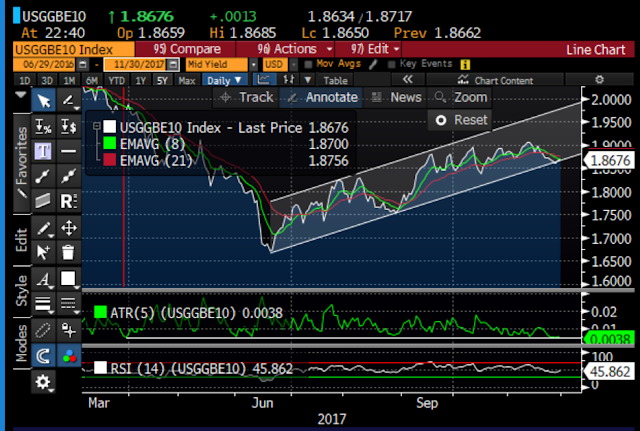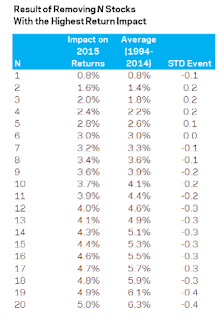Price makes news not the other way around
Now that the press is all over the recent curve flattening, the contrarian in me steps in
It may sound a little Monday morning quarterback but 5/30s flattening made and makes a lot of sense, a combination of...
- weaker US data (see previous post on Soft vs Hard data)
- weaker inflation (see previous post on expensiveness of the 5yr real yield, too high 5y BE and too steep a RY curve)
- weaker volatility and intense grab for yield
- Fed on the move, raising front end rates (maybe for the wrong reason afraid of bubble building more than economical reality)
- Fed discussions on balance sheet unwind (liquidity out of the system, probability of recession goes up, curve flattens)
- Underweight pensions and insurance creating convexity risk and need to receive long end
...and you get the perfect recipe for a flattener from a Momentum and Fundamental macro perspective.
Now Carry is still negative but a lot better than it used to be as roll down is less prohibitive (negative -3.4bps per 3mos in US meaningless compared to recent daily moves)
Value is also starting to turn, if I loved the flattener couple weeks ago, I think the curve is getting ahead of itself.
I don't trade against a major trend but if I have multiple units of risk I am starting to take profit to be able to reload at better levels.
Value measures
5/30s vs Swaps
Treasuries benefited from the announcement that bank regulations might get revised relaxing some of the major hurdles for banks balance sheet (SLR, LCR, NSFR...) so treasuries outperformed swap massively in the long end (10+bps)
5/30s treasury curve (orange) forced flattening in long end forwards and brought risk premiums down further
As you can see below it took long term forwards a couple of weeks/months to react.
5/30s global curves, again treasuries outperforming all
5/30s cash vs Real curves, inflation curve has mean reverted vs Cash treasuries
In March Tips curves was too steep vs Treasuries (see previous post)
Today Both curves are very flat
5yr treasuries vs Eurodollar curves, 5yr level is cheapish
Technicals
5/30s at multi decade trendline, trend intact from 2010 high
Tactically, 5/30s overdone short term, but reload at the break just above 100
All in all, if the trend is your friend and it might be hard to fight the flattener (from a pure historical basis Flattening has more room to go), I believe you will find better entry points in the next couple weeks as arbitrageurs take advantage of the recent flattening moves. So take some profit or play some mean reversion before reloading.
Even at depressed volatility measures the rates complex is offering good opportunities, a good omen for hedge fund managers in the rates relative value space.
A mean-reversion Case study showing again that Treasury curve is too flat at the moment
Similarly to the 5/30s curve, 2/10s curve has flattened pretty fast recently.
Here is an example of a mean reverting trade you could put on..
2/10s steepener treasuries vs ED8/12 flattener
The two time series are 95% correlated
I run a mean reversion test and results are ok.
The Hurst exponent is below 0.5 confirming mean reverting properties, the Dickey Fuller test was a little disappointing but still confirming mean reverting properties at the 10% confidence level
Graphically you can also notice the mean reversion in the residuals and the cheapness of the Eurodollar curve vs treasury curve above 2 stdev today
The half life of the mean reversion is 73 days, number I used to back-test the profitability of a basic mean reversion strategy.
The strategy is profitable with 6.17% annualized returns, despite a 22% max drawdown (backtest was not optimized for Drawdowns).
Sharpe is not huge at 0.54 but if you can diversify and add a couple of these in a larger portfolio, the portfolio sharpe should do just fine.
Like any mean-reversion process it is based on the stability of the relationship, every now and then some structural changes disrupt that relationship, in this case it is possible that the treasury curve and the Eurodollar curve stop moving in sync, either because some re-pricing is happening for risk premiums, some regulatory changes are impacting one side more than the other...the only solution is to have defined stop losses methodologies.
Conclusion
Long term the treasury curve should continue to flatten but today the speed of the move suggests to take profit and try some mean reversion strategies in the meanwhile.
























































